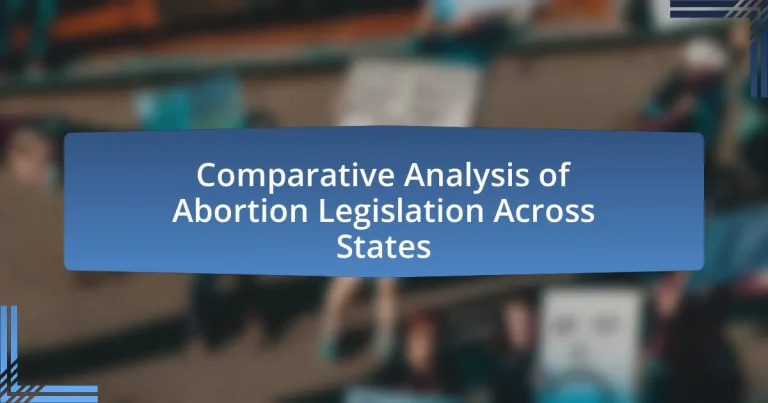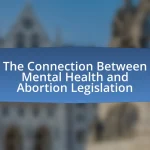The article provides a comparative analysis of abortion legislation across various states in the United States, highlighting significant differences in legal frameworks, access, and restrictions. It examines how states define abortion, the key legal terms involved, and the historical contexts that have shaped these laws. The article also discusses the implications of varying abortion laws on access to services, the barriers individuals face in restrictive states, and the influence of social movements and public opinion on legislative trends. Additionally, it outlines best practices for understanding and navigating state-specific abortion laws, along with available resources for individuals seeking abortion services.
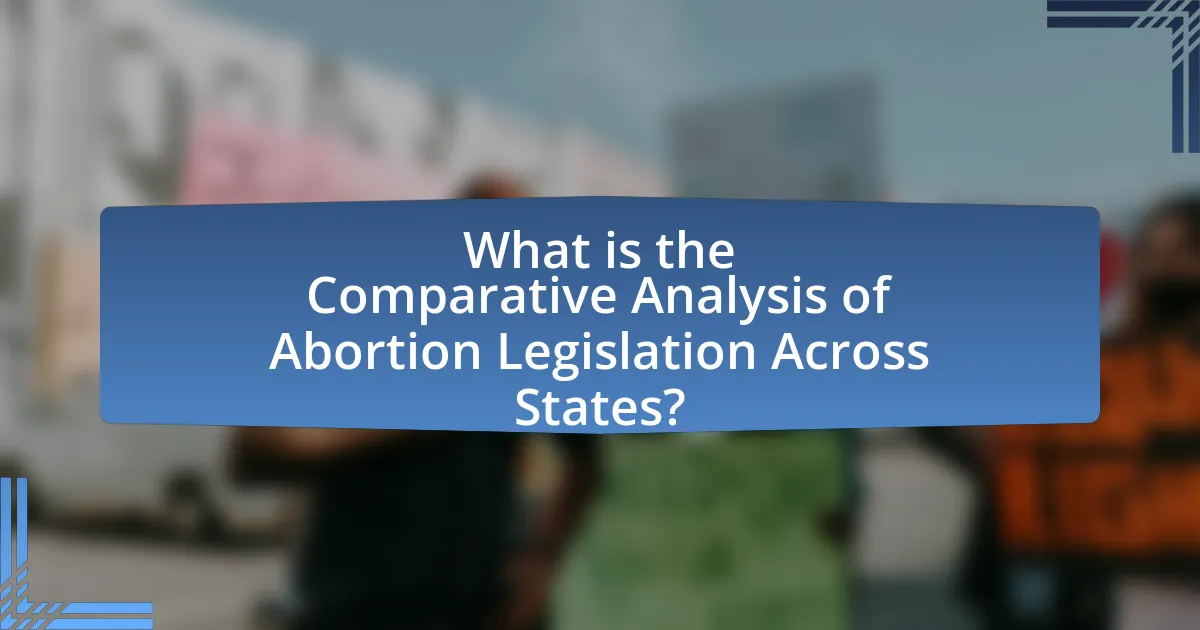
What is the Comparative Analysis of Abortion Legislation Across States?
The comparative analysis of abortion legislation across states reveals significant variations in legal frameworks, access, and restrictions. For instance, states like California and New York have enacted laws that protect and expand access to abortion services, allowing procedures up to viability and beyond in certain circumstances. In contrast, states such as Texas and Alabama have implemented stringent restrictions, including mandatory waiting periods, parental consent laws, and bans on abortions after a certain gestational age, often as early as six weeks. According to the Guttmacher Institute, as of 2023, 13 states have enacted total bans on abortion, while 16 states have laws that protect the right to abortion without gestational limits. This stark contrast illustrates the polarized landscape of abortion legislation in the United States, influenced by political, cultural, and social factors unique to each state.
How do different states define abortion in their legislation?
Different states define abortion in their legislation through varying gestational limits, conditions for legality, and specific terminology. For instance, some states, like Texas, define abortion as the termination of a pregnancy after a fetal heartbeat is detected, typically around six weeks, while others, such as California, allow abortion up to viability, which is generally considered to be around 24 weeks. Additionally, states like Alabama have enacted laws that define abortion as illegal except in cases of serious health risks to the mother, reflecting a more restrictive approach. These definitions are codified in state statutes and can significantly impact access to abortion services, as seen in the differing legal frameworks across the United States.
What are the key legal terms used in abortion laws?
Key legal terms used in abortion laws include “gestational limits,” which refer to the maximum number of weeks into a pregnancy that an abortion can legally be performed; “informed consent,” which mandates that individuals seeking an abortion receive specific information about the procedure; and “parental notification,” which requires minors to inform a parent or guardian before obtaining an abortion. Additionally, “waiting periods” are often stipulated, requiring individuals to wait a certain amount of time after an initial consultation before proceeding with the abortion. These terms are critical in understanding the regulatory framework governing abortion across different states, as they directly impact access and the legal landscape surrounding reproductive rights.
How do definitions vary between states?
Definitions of abortion vary significantly between states, influenced by local laws, cultural beliefs, and political climates. For instance, some states define abortion as the termination of a pregnancy at any stage, while others impose gestational limits, such as prohibiting abortions after six weeks. Additionally, states like California have broad definitions that include various methods of abortion, whereas states like Texas have more restrictive definitions that limit access and specify conditions under which abortions can be performed. These variations reflect the diverse legal frameworks and societal attitudes towards reproductive rights across the United States.
What are the historical contexts influencing state abortion laws?
Historical contexts influencing state abortion laws include the evolution of women’s rights, landmark Supreme Court decisions, and varying cultural and religious beliefs across states. The women’s rights movement, particularly in the 1960s and 1970s, advocated for reproductive rights, culminating in the 1973 Supreme Court decision in Roe v. Wade, which established a constitutional right to abortion. This ruling significantly impacted state laws, leading to a patchwork of regulations as states responded differently based on local values and political climates. Additionally, ongoing debates surrounding abortion reflect historical tensions between individual rights and moral considerations, further shaping the legal landscape.
How have landmark Supreme Court cases shaped state legislation?
Landmark Supreme Court cases have significantly shaped state legislation by establishing legal precedents that states must follow. For instance, the 1973 decision in Roe v. Wade recognized a woman’s constitutional right to choose an abortion, which led to states enacting laws that either protected or restricted access to abortion services. Following this ruling, states like California and New York implemented laws to safeguard abortion rights, while others, such as Texas, passed restrictive measures aimed at limiting access. Additionally, the 1992 case of Planned Parenthood v. Casey upheld Roe v. Wade but allowed states to impose certain regulations, further influencing state legislation by enabling them to enact waiting periods and parental consent laws. These cases illustrate how Supreme Court rulings directly impact the legislative landscape at the state level, shaping the rights and regulations surrounding abortion across the United States.
What role do social movements play in shaping abortion laws?
Social movements significantly influence the shaping of abortion laws by mobilizing public opinion, advocating for policy changes, and pressuring lawmakers. For instance, the pro-choice movement has historically organized campaigns, such as the 1973 Roe v. Wade decision, which legalized abortion in the United States, demonstrating the power of collective action in altering legal frameworks. Additionally, movements opposing abortion have also impacted legislation, leading to restrictions in various states, as seen with the rise of the anti-abortion movement in the late 20th century, which has resulted in numerous state-level laws aimed at limiting access to abortion services. These movements utilize strategies like protests, lobbying, and public education to create a societal context that influences legislative outcomes.
What are the primary components of abortion legislation across states?
The primary components of abortion legislation across states include gestational limits, mandatory waiting periods, parental consent requirements, and regulations on abortion providers. Gestational limits vary, with some states allowing abortions up to 20 weeks, while others restrict them to as early as six weeks. Mandatory waiting periods often require individuals to wait 24 to 72 hours after an initial consultation before proceeding with the procedure. Parental consent laws typically mandate that minors obtain permission from a parent or guardian before having an abortion. Additionally, regulations on abortion providers can include licensing requirements, facility standards, and restrictions on medication abortions. These components reflect the diverse legal landscape surrounding abortion in the United States, influenced by political, cultural, and social factors.
What regulations are commonly found in state abortion laws?
State abortion laws commonly include regulations such as mandatory waiting periods, parental consent requirements for minors, gestational limits, and informed consent provisions. For instance, many states require a waiting period of 24 to 72 hours between the initial consultation and the procedure, allowing individuals time to consider their decision. Parental consent laws mandate that minors obtain permission from a parent or guardian before undergoing an abortion, with some states allowing judicial bypass options. Gestational limits often restrict abortions after a certain number of weeks, typically ranging from 20 to 24 weeks, reflecting varying state interests in fetal viability. Informed consent laws require healthcare providers to offer specific information about the procedure, potential risks, and alternatives, ensuring that individuals make informed choices. These regulations vary significantly across states, reflecting differing political, cultural, and ethical perspectives on abortion.
How do waiting periods and parental consent laws differ?
Waiting periods and parental consent laws differ primarily in their purpose and application within abortion legislation. Waiting periods require individuals to wait a specified amount of time, often 24 to 72 hours, after receiving counseling before proceeding with an abortion, aimed at ensuring informed decision-making. In contrast, parental consent laws mandate that minors obtain permission from a parent or guardian before undergoing an abortion, focusing on parental involvement in the decision-making process. For instance, as of 2021, 27 states enforce waiting periods, while 37 states require parental involvement, highlighting the distinct regulatory approaches to abortion access.
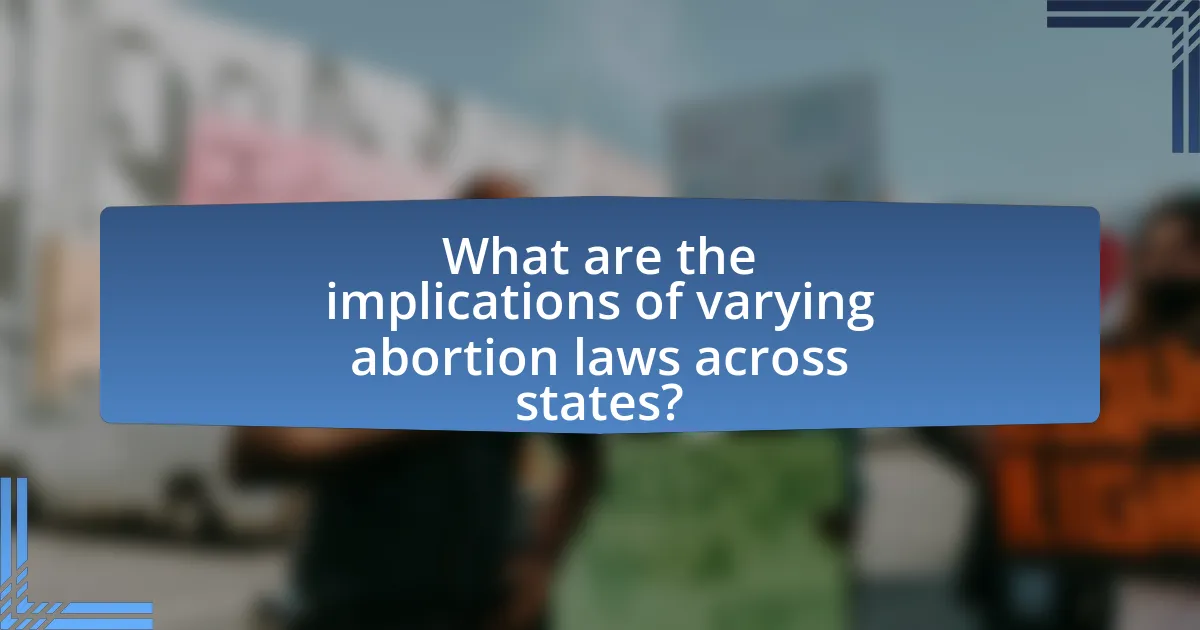
What are the implications of varying abortion laws across states?
Varying abortion laws across states lead to significant disparities in access to reproductive healthcare, impacting women’s health outcomes and socioeconomic conditions. For instance, states with restrictive laws often see increased travel distances for women seeking abortions, which can result in delays and increased costs, ultimately affecting their decision-making. Research from the Guttmacher Institute indicates that women in states with more restrictive laws are more likely to experience negative health outcomes due to limited access to safe abortion services. Additionally, these variations can create a patchwork of legal protections, leading to confusion and inequity, as women in different states face vastly different legal landscapes regarding their reproductive rights.
How do state laws affect access to abortion services?
State laws significantly influence access to abortion services by establishing regulations that can either facilitate or restrict availability. For instance, some states impose waiting periods, mandatory counseling, and parental consent laws, which can create barriers for individuals seeking abortions. According to the Guttmacher Institute, as of 2023, 26 states have enacted laws that limit access to abortion, including gestational limits and restrictions on medication abortion, which directly impacts the number of clinics and healthcare providers available to offer these services. These legal frameworks vary widely across the United States, leading to disparities in access based on geographic location, socioeconomic status, and individual circumstances.
What barriers do individuals face in states with restrictive laws?
Individuals in states with restrictive laws face significant barriers such as limited access to abortion services, increased travel distances to clinics, and financial constraints. For instance, many states impose mandatory waiting periods and parental consent requirements, which can delay access and create additional logistical challenges. According to the Guttmacher Institute, as of 2023, 26 states have enacted laws that severely limit abortion access, leading to a disproportionate impact on low-income individuals and marginalized communities who may lack the resources to travel to states with fewer restrictions. These barriers contribute to health disparities and can force individuals to carry unwanted pregnancies to term, impacting their physical and mental well-being.
How do access issues vary by geographic location within states?
Access issues to abortion services vary significantly by geographic location within states, primarily influenced by urban versus rural settings. Urban areas typically have more healthcare facilities, providers, and resources, leading to greater access to abortion services. For example, states like California and New York have numerous clinics in metropolitan areas, while rural regions often face clinic closures and longer travel distances, limiting access. According to the Guttmacher Institute, 90% of U.S. counties lack an abortion provider, with rural counties disproportionately affected. This disparity highlights the critical impact of geographic location on access to abortion services within states.
What are the potential legal consequences of violating abortion laws?
Violating abortion laws can lead to severe legal consequences, including criminal charges, fines, and imprisonment. For instance, in several states, performing an illegal abortion can result in felony charges, which may carry sentences of several years in prison. Additionally, healthcare providers who violate these laws may face professional disciplinary actions, including the loss of medical licenses. In states with strict abortion regulations, penalties can also extend to individuals assisting in the procedure, leading to further legal repercussions. These consequences are enforced to uphold state-specific abortion laws, which vary significantly across the United States.
What penalties do states impose for illegal abortions?
States impose various penalties for illegal abortions, which can include criminal charges, fines, and imprisonment. For instance, some states classify illegal abortions as felonies, resulting in significant prison sentences, while others may impose misdemeanor charges with lesser penalties. In Texas, for example, individuals performing illegal abortions can face up to 99 years in prison, reflecting the state’s stringent stance on abortion laws. Additionally, fines can range from thousands to tens of thousands of dollars, depending on the jurisdiction and specific circumstances of the violation. These penalties serve as a deterrent and reflect the varying legal frameworks surrounding abortion across different states.
How do enforcement practices differ among states?
Enforcement practices regarding abortion legislation differ significantly among states, primarily due to variations in legal frameworks, political climates, and resource allocation. For instance, some states have stringent enforcement mechanisms, including mandatory reporting requirements and penalties for non-compliance, while others adopt a more lenient approach, focusing on education and access rather than punitive measures. A study by the Guttmacher Institute highlights that states like Texas and Alabama have implemented strict regulations and aggressive enforcement tactics, resulting in clinic closures and reduced access to services. In contrast, states such as California and New York prioritize reproductive health access and have fewer restrictions, leading to more supportive enforcement practices. These differences reflect broader ideological divides and impact the availability of abortion services across the United States.
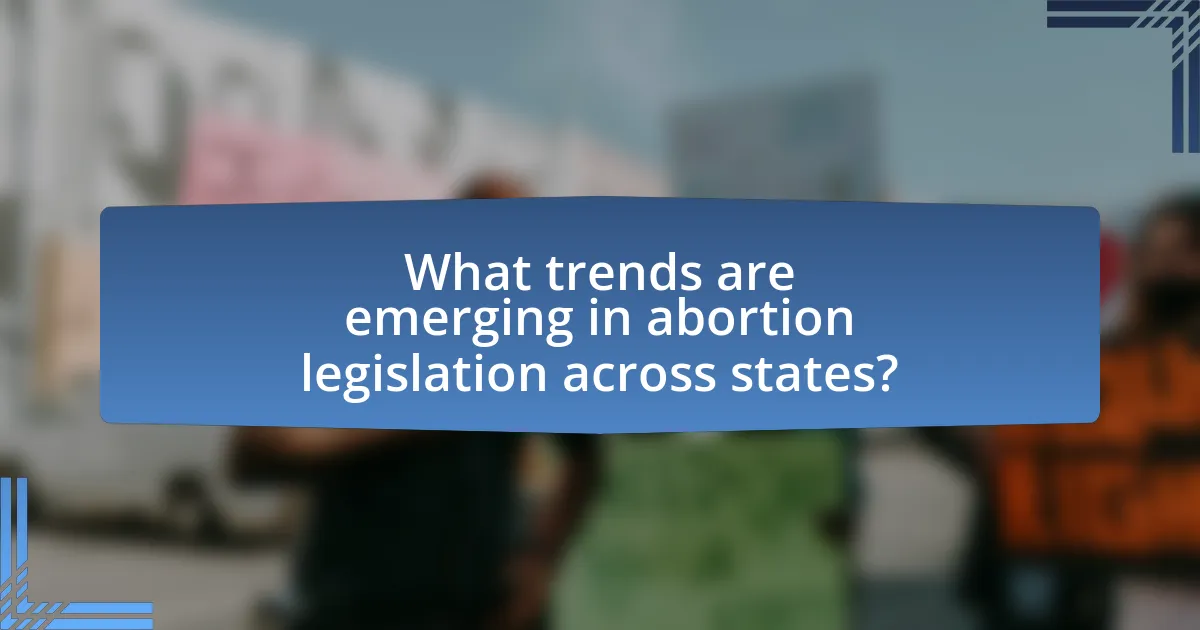
What trends are emerging in abortion legislation across states?
Emerging trends in abortion legislation across states include increased restrictions and a rise in protective measures for access. Following the Supreme Court’s decision in Dobbs v. Jackson Women’s Health Organization in 2022, many states enacted laws that significantly limit abortion access, with at least 13 states implementing near-total bans. Conversely, several states, particularly those with Democratic leadership, have enacted laws to safeguard abortion rights, expanding access and protecting providers. For instance, California and New York have strengthened legal protections for abortion services, reflecting a growing divide in state policies. This trend indicates a polarization in abortion legislation, with states either moving towards stricter regulations or enhancing protections for reproductive rights.
How are recent political changes influencing abortion laws?
Recent political changes are significantly influencing abortion laws by shifting the balance of power between state legislatures and federal oversight. For instance, following the Supreme Court’s decision in Dobbs v. Jackson Women’s Health Organization in 2022, many states enacted stricter abortion regulations or outright bans, reflecting the political ideologies of their governing bodies. In states like Texas and Florida, Republican-led legislatures have passed laws that severely restrict access to abortion services, while Democratic-led states such as California and New York have moved to protect and expand abortion rights. This divergence illustrates how political affiliations directly impact legislative outcomes regarding abortion, with states responding to their political climates and voter sentiments.
What legislative trends have been observed in the last decade?
In the last decade, significant legislative trends in abortion legislation across states include an increase in restrictive laws and a rise in legal challenges to these laws. Many states have enacted measures such as mandatory waiting periods, parental consent requirements, and gestational limits, reflecting a trend towards limiting access to abortion services. For instance, between 2011 and 2021, over 500 abortion restrictions were enacted in various states, with states like Texas and Alabama leading in the implementation of stringent laws. Additionally, the trend has seen a corresponding increase in court cases challenging these laws, particularly in light of the U.S. Supreme Court’s decisions, which have influenced state-level legislation.
How do public opinion and activism shape future legislation?
Public opinion and activism significantly influence future legislation by creating pressure on lawmakers to respond to the views and demands of their constituents. For instance, in the context of abortion legislation, widespread public support for reproductive rights has led to the introduction and passage of laws that protect access to abortion services in various states. According to a 2021 Gallup poll, 58% of Americans identified as pro-choice, which has prompted legislators to consider this majority stance when drafting laws. Activist groups, such as Planned Parenthood and the American Civil Liberties Union, mobilize grassroots campaigns, organize protests, and engage in lobbying efforts, further amplifying public sentiment and compelling legislators to act in alignment with the prevailing public opinion. This dynamic illustrates how the interplay between public sentiment and organized activism can shape legislative outcomes, particularly in contentious areas like abortion rights.
What are the best practices for understanding and navigating state abortion laws?
To understand and navigate state abortion laws effectively, individuals should first familiarize themselves with the specific laws and regulations in their state, as these can vary significantly. Researching state-specific resources, such as government websites and legal aid organizations, provides accurate and up-to-date information. Additionally, consulting legal professionals who specialize in reproductive rights can offer personalized guidance and clarify complex legal language. Engaging with local advocacy groups can also provide insights into recent changes and community resources available for support. According to the Guttmacher Institute, as of 2023, over 30 states have enacted laws that restrict access to abortion, highlighting the importance of staying informed about ongoing legislative developments.
How can individuals stay informed about changes in legislation?
Individuals can stay informed about changes in legislation by subscribing to reputable news outlets, following government websites, and utilizing legislative tracking services. Reputable news outlets often provide timely updates on legislative changes, while government websites, such as state legislatures, publish official information regarding new laws and amendments. Legislative tracking services, like GovTrack or LegiScan, offer tools to monitor specific bills and legislative activities, ensuring individuals receive alerts about relevant changes. These methods collectively enhance awareness and understanding of evolving legislation, particularly in areas such as abortion laws, which can vary significantly across states.
What resources are available for those seeking abortion services across states?
Individuals seeking abortion services across states can access various resources, including national hotlines, local clinics, and online platforms. The National Abortion Federation provides a hotline (1-800-772-9100) that connects individuals to nearby abortion providers and offers information on financial assistance. Planned Parenthood operates numerous health centers across the United States, providing abortion services and comprehensive reproductive health care. Additionally, websites like AbortionFinder.org allow users to search for clinics by state and provide information on the services offered, including medication and in-clinic abortions. These resources are crucial for navigating the differing abortion laws and access points across states.
